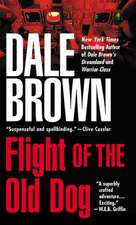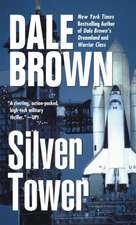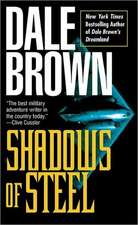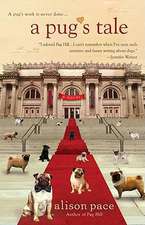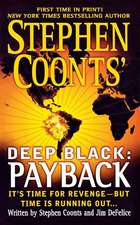Dreamland
Autor Dale Brown, James DeFeliceen Limba Engleză Paperback – 31 mai 2001 – vârsta de la 18 ani
Hidden in the Nevada desert is America’s most advanced aerospace weapons testing facility. Dreamland is the place where the nation’s top minds come to develop artillery and aircraft that push beyond the cutting edge. And where the Air Force’s top guns come to test them—on the front lines of a new era in warfare… The fiasco of a spy’s infiltration has the Pentagon looking for an excuse to close Dreamland down. To clean up the mess—and save Dreamland from the Congressional chopping block—Lt. Colonel William Tecumseh “Dog” Bastian is sent in. He’s just the guy to shake things up…and does when a situation erupts in Somalia. Into a hotter-than-hot war zone, he sends his own daughter—the pilot of a Megafortress bomber—and a high-tech, unmanned flight system that could make or break the future of Dreamland…
Preț: 54.36 lei
Nou
Puncte Express: 82
Preț estimativ în valută:
10.40€ • 11.33$ • 8.77£
10.40€ • 11.33$ • 8.77£
Carte disponibilă
Livrare economică 02-16 aprilie
Preluare comenzi: 021 569.72.76
Specificații
ISBN-13: 9780425181201
ISBN-10: 0425181200
Pagini: 375
Dimensiuni: 108 x 172 x 27 mm
Greutate: 0.2 kg
Editura: Berkley Publishing Group
ISBN-10: 0425181200
Pagini: 375
Dimensiuni: 108 x 172 x 27 mm
Greutate: 0.2 kg
Editura: Berkley Publishing Group
Notă biografică
Former U.S. Air Force captain Dale Brown is the author of several best-selling military-action-aviation-adventure novels: Flight of the Old Dog (1987), Silver Tower (1988), Day of the Cheetah (1989), Hammerheads (1990), Sky Masters (1991), Night of the Hawk (1992), Chains of Command (1993), Storming Heaven (1994) and Shadows of Steel (1996). Dale's novels are published in 11 languages and distributed to over 70 countries.
Dale was born in Buffalo, New York on November 2, 1956. He graduated from Penn State University and received an Air Force commission in 1978. He was a navigator-bombardier in the B-52G Stratofortress heavy bomber and the FB-111A supersonic medium bomber, and is the recipient of several military decorations and awards including the Air Force Commendation Medal with oak leaf cluster, the Combat Crew Award, and the Marksmanship ribbon. He flew over 2500 hours in various military tactical and training aircraft from 1978 to 1986 and was also a graduate of the U.S. Army Airborne School.
Dale is a volunteer pilot for AirLifeLine, a non-profit national charitable medical transportation organization who fly needy persons free of charge to receive treatment. He also supports a number of organizations to support and promote law enforcement and reading. He is a member of the Airplane Owners and Pilots Association, The Writers Guild, and a Life Member of the Air Force Association and U.S. Naval Institute. He is a multi-engine and instrument-rated private pilot and can often be found in the skies all across the United States, piloting his Piper Aerostar 602P. On the ground, Dale enjoys tennis, scuba diving, and hockey. He lives in Incline Village, Nevada.
Dale was born in Buffalo, New York on November 2, 1956. He graduated from Penn State University and received an Air Force commission in 1978. He was a navigator-bombardier in the B-52G Stratofortress heavy bomber and the FB-111A supersonic medium bomber, and is the recipient of several military decorations and awards including the Air Force Commendation Medal with oak leaf cluster, the Combat Crew Award, and the Marksmanship ribbon. He flew over 2500 hours in various military tactical and training aircraft from 1978 to 1986 and was also a graduate of the U.S. Army Airborne School.
Dale is a volunteer pilot for AirLifeLine, a non-profit national charitable medical transportation organization who fly needy persons free of charge to receive treatment. He also supports a number of organizations to support and promote law enforcement and reading. He is a member of the Airplane Owners and Pilots Association, The Writers Guild, and a Life Member of the Air Force Association and U.S. Naval Institute. He is a multi-engine and instrument-rated private pilot and can often be found in the skies all across the United States, piloting his Piper Aerostar 602P. On the ground, Dale enjoys tennis, scuba diving, and hockey. He lives in Incline Village, Nevada.
Extras
Chapter One: Down for Doubles Air Force High Technology Aerospace
Weapons Center (Dreamland), Nevada
10 October 1995, 0530 PDT
Gravity smashed against his head so hard he nearly eased off on the stick. That would have been fatal—the butt of Major Jeff Zen” Stockard’s Strike Eagle was dancing across the boresight of a pursuing fighter at optimum cannon range. Stockard’s only hope was to yank and bank away, zigging and zagging in a wild twist across the desert sky, pulling between six and seven g’s as he tried to escape. He tightened his fingers around the control stick and hung on.
Zen had done this a million times—in fact, he’d fought this very same dogfight on a simulator the day before. But that was then, this was now. The simulator could only approximate what the slashing maneuvers did to his body. His neck and shoulders especially—the helmet he had to wear to control his remote escorts weighed more than forty pounds. The helmet used holographic imaging to provide enhanced optical and sensor views from both his plane and the escorts; its oval master view could be divided in half or quarters by voice command or the push of a button on his specially designed control stick. The skull bucket, with its onboard microprocessors, thick layers of LEDs, and retina-scan circuits, was critical to his mission, but that was no comfort when the sudden slash of his maneuvers increased its weight exponentially. The F-15E’s ACES II ejector seat had been modified to help support it, but Zen still worried that his head was going to snap right off his body as he pushed through the seven-g turn.
Even with normal gear, seven g’s would have hurt. The cells in his pressurized suit worked against his body like a masseuse’s hands, fighting to keep his blood in place. But he was out at the edge of his endurance. Zen’s heart pounded violently in his chest as he rammed his F-15E Eagle back to the right, picking his nose up and then flailing back over in a barely controlled reverse dive.
Bitchin’ Betty—the plane’s English-language audio warning system—whined that he was about to become toast. Too many g’s, too fat a target, too little airspeed.
It might also have complained about his housekeeping, for all the attention he paid to it.
Stockard pushed the nose around, gaining just enough momentum to miss his pursuer’s snap shot as he recovered. He had to hold on for at least another ten seconds before his escorts caught up. If he lasted that long, the fighter hunting him would become the hunted.
If he didn’t: toast.
Major Mack “Knife” Smith cursed as Stockard’s Strike Eagle once more slid out of his targeting pipper without cuing the signal that meant he’d splashed the SOB. If there had been real slugs in his F-15C’s M61A1 cannon, he was sure he’d have nailed Stockard by now. But even though the laser designator had danced back and forth across the Strike Eagle’s left wing and fuselage, the computer-controlled SiCS, or Simulated Cannonfire Scoring system, refused to record a fatal hit.
Only reason for that, he decided, was that he was supposed to be profiling an Su-27, with its notoriously inaccurate fire-control system. Had to be. That or someone had rigged the gear against him.
Knife tucked his Eagle down to follow Stockard into a rolling dive. Stockard was clever—he was trying to get Knife to either speed up and fly right by him, or slow down enough to let the two Flighthawks catch up. The Flighthawk U/MF-3’s were the purpose of this exercise. Flying as escorts controlled by Zen, the two robot aircraft were supposed to keep Knife from shooting down the Strike Eagle. The exercise was designed to push the mini-planes and their human commander to the limit.
Which was fine with Knife. As long as he nailed the SOB.
Stockard’s left wing slid downward, and the plane seemed to literally drop from the sky. Knife pushed his nose down before realizing what was going on. Zen was twirling through an invert as he dove, aiming to swoop off at close to ninety degrees. Knife had no choice now but to follow—anything else would let the escorts catch up.
He matched the spin, catching a glimpse of one of the Flighthawks trailing him. He ignored it—if he could see it, it wasn’t in position to nail him, he decided—and concentrated on Stockard, whose rear tail fins were still disappearing below his HUD. Stockard was below ten thousand feet.
So much for the rules of engagement. Not that Knife would have let them stop him from winning either. But it was a relief that the other guy had ignored them first.
Stockard’s fantail sailed into Mack’s targeting pipper, and he pressed the trigger.
No good. Stockard pulled left just in time to duck the shot, recovering at eight thousand feet.
The g forces kicked up by the maneuvers tore Knife in all different directions; he felt like he was being pinched and pulled at the same time. A dark cloud began edging toward the corners of his eyes as he saw Zen flicking to the right. He pulled at the Eagle’s stick to follow, worrying in the back of his mind that the extreme maneuvers would flame the Eagle’s nearly unflammable engines.
And then he realized he’d blown it.
Zen pushed his stick to level his wings, feeling for the plane with his arms and legs. He’d faked Smith out, but the rush of gravity was nearly too much; he felt his head starting to implode. If he were flying only the Strike Eagle he’d be fine, but he had to guide the Flighthawks as well. Even with the computer guidance system carrying most of the load, it was too much work; his brain started caving under the physical and mental stress.
That was the point of all this, right? To find the limits?
Okay, he told himself, I’m here, I’m doing this. The bar at the top of his visor screen flashed green. It meant one of his escorts was now within firing range.
Okay, he repeated to himself. I’m home. All I have to do is flick my thumb down and enable the Flighthawk forward cams.
If Zen could do that, the heavy visor in his helmet would project two three-dimensional holograms in front of his eyes, each view projected from the nose of one of the U/MF-3’s. He’d say “Hawk One” or “Hawk Two,” look directly at his target, select cannon, fire. End of exercise.
But before he could do that, the center of his screen flashed red, indicating that the F-15C behind him was firing its simulated cannon. He jinked left, his consciousness narrowing to a pinprick of pure white light in a round black night.
Smith had all the stops out. He wasn’t flying the F-15C as if it were a Sukhoi, with its limited avionics and conservative flight regimes. He’d tossed aside the flight protocol and briefed plan and was flying like an American—balls-out, over the line.
Fair enough, thought Zen, pulling back left, swirling in a scissors. The green firing bar disappeared—the Flighthawks had lost the shot. The little planes were extremely agile, but the computers that helped control them were not yet as creative as human pilots in close-in furballs.
Zen yanked his nose down hard, barely escaping one more time.
His head started to float. He’d pushed too far.
Zen forced air into his lungs, forced his muscles to relax, forced the blackness away. The green bar appeared and this time he mashed his thumb downward right away, saw Smith’s butt hanging fat in Hawk One’s boresight.
“Hawk One,” he told the control computer. “Cannon.”
“Ready,” replied the computer.
“Fire.”
Knife cursed as the SiCS buzzer announced that he had been fried. He eased off on his stick and checked his power, leveling off as he reoriented himself. The dogfight had taken them to the edge of the restricted airspace Dreamland had set aside for the Flighthawk test; he began a bank south.
“Dreamland Playboy One, this is Hawk Mother,” Zen radioed. “You’re dirt.”
“Yeah, no shit,” Smith snapped. The transmissions were monitored as well as recorded, but at the moment Knife didn’t care if anyone thought he was a sore loser. It was the first time he’d lost to Zen in three weeks’ worth of mock battles. The point of the exercises was to test and improve the Flighthawk U/MF-3’s, and it could be argued that his previous victories had greatly enhanced the unmanned escort program, helping to improve the combat computer programming so the miniature planes would be useful twenty-first-century weapons.
It could also be argued that three against one wasn’t a fair fight. Nor were the exercise’s rules of engagement, which called for him to approach the Strike Eagle as if he were an Su-27, slower and higher than optimum.
Somehow, none of those things made him feel any better.
“Let’s go again,” suggested Stockard. “Down for doubles.”
“Oh, you got it,” said Knife. He glanced at his fuel gauge to make sure he had gas, then ran his eyes over the rest of the Eagle’s instruments. He knew from feel that the plane was at dash-one spec—but he also knew that relying on feel could be a quick ticket to the boneyard.
“Point Zero in zero one,” added Stockard, meaning that he and his escorts would be back at his starting position in sixty seconds.
Knife gave a terse acknowledgment and headed toward the end of the range. What he wouldn’t give to be flying the Cheetah, the advanced-airframe F-15. Its forward canards and maneuverable thrust nozzles enabled the plane to cut nearly straight lines in the sky. He would have nailed Stockard on his first pass.
He would have nailed him if he hadn’t had to worry about the Flighthawks. Three against one.
All right, he told himself. Stop making excuses and get to work.
Knife pushed himself forward against his restraints as he reached his starting point at the edge of the restricted airspace. He was ready. He’d nail that SOB, Flighthawks or no Flighthawks. This time he wasn’t holding back.
Zen replayed the final thirty seconds of the dogfight in the lower left quadrant of his high-tech visor while he waited for Smith. The herky-jerky images made it clear the Flighthawk project had a long way to go. The U/MF-3 flight computers simply hadn’t been able to keep up with the two manned planes; luck as well as skill had saved Zen’s butt from being fried.
Admittedly, carrying a dedicated Flighthawk remote pilot in the Eagle’s backseat would have helped. But the point of this particular experiment, and indeed the entire program, was to see if the remote planes could operate with minimal human guidance—if, in fact, a single pilot on a combat mission could control them while trying to evade an enemy aircraft. Besides, the com equipment and communications gear were so large there was no way to get anyone else into the plane.
Even though Zen had just nailed Smith, he felt that he had failed. He knew he was being incredibly hard on himself. But he’d had to go all out to do it. If he had been flying a strike mission, he would not have been able to complete the bombing run. Zen was the sort of pilot, the sort of man, who accepted nothing less than perfection. Settling for what was possible simply wasn’t good enough.
The U/MF-3’s were in a shadow orbit, slightly offset and trailing his wings at a half mile as he circled over the Nevada desert. It was a standard Flighthawk maneuver, one that he could tell the computer to execute and forget about, though he had the Flighthawks’ God’s-eye view selected on his helmet monitor just in case.
The U/MF’s were about the size of Miata sports cars, with delta-shaped knife wings and small canard wings. Their tail sections looked like miniature versions of the F-
23’s, canted off in a squashed V. Powered by specially designed and downsized versions of the Pratt &Whitney F-119-PW-100 without an afterburner section, the planes were theoretically more maneuverable than the F-15 or even the F-22, but without the top-end speed of either plane. On the other hand, their size and wing configurations made them essentially invisible to radar beyond three miles. The Flighthawks were intended as multi-role escort craft for high-performance attack planes on difficult deep-strike missions. They could be configured for reconnaissance as well as close combat, and the engineers who had drawn up the plans foresaw the day when a high-megawatt oxygen-iodine laser would fill the robots’ weapons bays.
That day seemed far, far in the future. The smallest oxygen-iodine laser in the world—not coincidentally under development at the top-secret base below—wouldn’t fit inside a 747 without some serious alterations.
The Flighthawks themselves had a way to go. Routine flight patterns were preprogrammed, and the small planes had enough native” intelligence to follow simple commands, like prepare a nose-intercept with an approaching bandit. But complex commands and maneuvers had to be broken down and explained to the planes. That took time and computing power. The scientists responsible for the project had promised faster and smaller computers based on near-room-temperature super-conducting chips (NRTSC) similar to those in the XF-34A DreamStar, the next generation interceptor seen as a potential successor to the F-22 Raptor. DreamStar’s computer advances were numerous and so complicated that Zen had only a vague idea what they involved; still, he knew it was just a matter of time before they found their way from the XF-34A to the Flighthawks.
Even when they did, communications bandwidth might still be a problem. Since any communications could be jammed or compromised in a combat situation, the Flighthawks used an elaborate mix of laser and radio bands. Once they were in combat mode, everything went through three layers of 128-byte encryption. There was a brief but noticeable delay between command and execution in some flight regimes.
Zen checked his fuel and reviewed his flight data. He was back at twenty thousand feet, meandering at the edge of the restricted test range at 420 knots. Smith should have reached the end of the range by now. Zen stared out the canopy toward the southeast. Nellis Air Force Base, one of the busiest in the world, lay fifteen miles to the south, but with the heavy air restrictions in force, you’d never know it was so close.
Zen flicked the Eagle’s radar into air-to-air medium-
range mode, scanning out ten miles to where his opponent ought to be turning around.
No contact.
No contact?
Zen started to key his mike when he realized what Knife was up to. His left hand pulled the throttle to goose the afterburners and getaway.
It was almost too easy. Knife gunned the engines and jerked the nose of his Eagle off the deck, rising from fifty feet AGL as he swung up behind the Flighthawks. Stockard lit his afterburners, but that didn’t matter—the Flighthawks were caught flat-footed. Hawk One tried to follow its mother ship, but its small engine was overmatched: The silvery hull slid precisely into the middle of the square target indicator of Knife’s HUD. The Flighthawk started to jink left, but it was too late—the M61A1 Vulcan chewed it up.
Or rather, the SiCS bleeped to say it did.
Knife’s P&Ws were burning at 115 percent, and within seconds his F-15’s APG-63 radar tapped the second Flighthawk, just out of cannon range. Knife nudged his stick to the left as he closed, squaring in for a bull’s-eye.
Except the Flighthawk ducked off to the right, dropping down so fast he couldn’t react. But that was fine—his goal was to splash Zen, not the high-tech UAVs. And now that the Flighthawk had runaway, Zen’s unprotected butt loomed at the top of his windscreen. Knife took a breath, adrenaline careening through his veins as he closed for the kill.
Damn good thing they were playing by cannon rules or he’d be dead, Zen thought as he jerked Hawk Two away. Sidewinder would have walloped him.
Then again, according to the rules, Knife was supposed to be about ten thousand feet higher, not flying low enough to stop for traffic lights.
Not that fighter pilots were expected to follow the rules, let alone fight fair.
Smith was probably pissed that he’d beaten him in the first round, and wanted revenge. That would make beating him again all the sweeter, wouldn’t it?
Zen waited until he was sure Mack was coming for him before ordering the remaining Flighthawk to try to acquire his opponent’s tail. Then he brought his full attention back to his own plight. The two planes were fairly well matched; Zen’s slightly more powerful power plants made up for the fact that Smith’s plane was a tad lighter. As long as they both had the pedal to the metal, Smith couldn’t catch him.
Then again, Zen wouldn’t be able to getaway either. Nor would he be able to splash Smith, which was what he really wanted.
Duck and roll?
Smith wouldn’t be fooled by it twice.
Feint left, plunge right, swing back in a high-speed scissors, twisting around to let the Flighthawk nail Smith in a front-quarter attack.
Not easy, but also probably the last thing Smith would be expecting, since the U/MF-3’s were not adept at head-on attacks. As the Flighthawk took its shot, Zen could buck into a tight loop and come up behind him. He’d have him for dinner.
Maybe. Very hard to execute, especially with half of his attention on the Flighthawk.
Go for it.
Zen backed his power off, sucking Smith toward him. As his warner buzzed, telling him that he was about to be nailed, Zen pushed left. He counted off two seconds, then came back hard right, rolling the plane downward with a burst of speed that got him out to Mach 1.2. Knife hesitated for a second, then began to follow.
Perfect. Zen slashed through the air like a ribbon unwinding from a spool, Smith barely hanging on. Stockard opened the Flighthawk visual screen in the lower right quadrant of his viewer, and asked for a sit map—a synthetic overhead or God’s-eye view—in the lower left.
Hawk Two was too far off the pace to complete the deal.
Cursing, Zen threw the Eagle over his shoulder, sliding and spinning downward to try to buy more time. Smith managed a snap shot, but couldn’t keep him in his target aperture long enough for the SiCS system to register a hit.
“Yo, scumbag, I would have put a half-dozen slugs in your wing on that shot,” snarled Knife. “Damn SiCs.”
Zen didn’t give him the satisfaction of an answer. He had to go hard on the stick as Smith dashed downward, cutting between him and the approaching Flighthawk.
Nice. Though the maneuver left Smith without a shot and potentially vulnerable himself, Zen was cut off and without enough forward energy to do anything but put his nose back down and try to pick up steam. Smith was on him again, accelerating across his path just when he thought he might try to recover. Zen threw the Eagle back down, slicing down to his left and then over into another invert as Smith somehow managed to twist his F-15C onto his tail.
The two planes twirled an elaborate ribbon in the sky, at times only ten feet apart. Zen played slapstick, ducking and bobbing just enough to keep from getting waxed. Finally he managed to get into a turn too tight for Smith to stay with; his pursuer had to back off or run the risk of overshooting him and becoming the target.
At that point, Zen should have transmitted the command “Knock it off” and ended the exercise. He’d fallen below three thousand feet and was low on fuel. He had only nominal control of Hawk One. He was far outside the stated parameters of the test. Both he and Knife had been rockin’ and rollin’ for more than an hour. Both had gotten out of bed shortly after midnight to begin the rigorous preflight procedures that were considered an important part of the experiment. He had also, by the standards of the experiment if not those he personally lived by, won the engagement. The inquiry would note all of this, in a pointed aside.
But neither Zen, nor Smith for that matter, was about to give up.
Zen cut south on a direct intercept for Hawk Two, determined to get his robot escort back into the furball. He’d used his air brake to make his last slash, which had cost him considerable flight energy, and as he jinked onto the new vector he got a stall warning. He dropped lower, quickly picking up speed, pouring on the gas as he streaked toward the desert floor. The Flighthawk, apparently confused by the twists of its target, was flying toward him at roughly ten o’clock, its own speed down to four hundred knots. Zen told the Flighthawk computer to plot a fresh nose-on-nose intercept with Smith, who by now had turned back around and had the stops out in pursuit. The plan was simple, a slight variation of the one he’d originally intended—the Flighthawk would force Knife to break; Zen would come back around and nail him from the rear.
Then he’d go home. He was bingo fuel.
“I’m coming for you, Zen,” gloated Smith.
“Hawk One, cannon,” Zen commanded.
“Not locked,” replied the computer, voice mode duplicating the visual indicator. “Outside range.”
They were at six hundred feet indicated, descending at a very slight angle. Smith was right on his tail, almost in range.
“Extreme range. Cannon,” commanded Zen.
“Not locked,” answered the computer. “Outside range.”
“Time to range,” said Zen.
“Five seconds,” said the computer.
Three too many. Zen twinged the rudder, hoping Smith would think he was planning a sharp cut. Then he held steady.
Knife bought it, but only for a second. Zen could practically feel his bad breath on his neck.
“I’m coming,” hissed Knife.
The Flighthawk bar went green.
“Fire!” screamed Zen.
As the Flighthawk fired, Knife broke downward. The move—dangerous as well as brilliant, since they were now only five hundred feet over the desert floor—caught Zen by surprise. Zen started to pull up, then realized Knife had simply yo-yoed beneath him and was about to nail his belly. Stockard shoved the F-15 into a hard right turn. As he did, he gave the Flighthawk a command to break off its attack.
In the next second, a shudder ran through Zen’s body, something he’d never felt before. It was like a tickle from inside, starting in the middle of his spine and flashing like lightning into every muscle. His hands and feet went cold, his toes froze. The steady roar of the big Pratt &Whitneys behind Zen stopped.
The sensation lasted a bare millionth of a second. It was followed by a hard slam and an unbearably loud screech, then silence.
The Flighthawk had sheared through the wing of Zen’s plane.
By the time the SiCS bleeped with the hit, Knife had pulled the plane onto its back, rolled level, and was trying desperately to regain altitude and forward airspeed. For a moment, he lost track of everything—his target, the Flighthawk, even the ground and the sky. Blood rushed furiously around his brain, its flow distorted by the centrifugal forces of his hard-stick maneuvers. For a second or two, Knife flew on instinct alone, his arms and legs sorting what his mind could not. They got the plane stable, kept it in the air, even pushed his eyes where they belonged.
Okay, he heard himself say. Okay. I nailed him.
The fuzz cleared and he was back in control, banking and climbing. Something big was tumbling across the sky above him. Gray foam seemed to shoot from its sides.
It took Knife nearly three full seconds to realize it was Stockard’s plane. Somehow he’d lost control and was cartwheeling across the sky.
There was no way to hold the plane. It defied gravity and every known law of Newtonian physics, moving in four directions at once, backward and forward, up and down.
Then everything stopped, time as well as the plane. It seemed to Zen that he could pop the canopy, undo his restraints, and step out. It seemed to Zen that he could stand on the seat and walk over the fuselage and look down at the sheared wing. He’d crouch and shake his head. Straightening with a grunt, he’d walk to the other wing and step off. It seemed to Zen he would trot down into the desert, running at an easy pace across the test range, back to his bunk at Dreamland.
Just when he decided he would do that, things began moving again, spinning with the force of a tornado. Zen’s eyes fell to the yellow eject handles next to the seat. He realized he was too low and moving too fast to eject; the plane was tumbling and there was no way he was getting out alive. At best, he’d go out sideways and the chute wouldn’t open and with his luck he’d fly through Smith’s wing, though that would serve the SOB right.
His arms were paralyzed and he couldn’t move anyway, and Zen took a breath and closed his eyes, ready to die.
Then there was a fierce wind around him and he realized he’d already yanked the handles.
—Reprinted from Dreamland by Dale Brown and Jim DeFelice by permission of Berkley, a member of Penguin Putnam Inc. Copyright © 2001. All rights reserved. This excerpt, or any parts thereof, may not be reproduced in any form without permission.
Weapons Center (Dreamland), Nevada
10 October 1995, 0530 PDT
Gravity smashed against his head so hard he nearly eased off on the stick. That would have been fatal—the butt of Major Jeff Zen” Stockard’s Strike Eagle was dancing across the boresight of a pursuing fighter at optimum cannon range. Stockard’s only hope was to yank and bank away, zigging and zagging in a wild twist across the desert sky, pulling between six and seven g’s as he tried to escape. He tightened his fingers around the control stick and hung on.
Zen had done this a million times—in fact, he’d fought this very same dogfight on a simulator the day before. But that was then, this was now. The simulator could only approximate what the slashing maneuvers did to his body. His neck and shoulders especially—the helmet he had to wear to control his remote escorts weighed more than forty pounds. The helmet used holographic imaging to provide enhanced optical and sensor views from both his plane and the escorts; its oval master view could be divided in half or quarters by voice command or the push of a button on his specially designed control stick. The skull bucket, with its onboard microprocessors, thick layers of LEDs, and retina-scan circuits, was critical to his mission, but that was no comfort when the sudden slash of his maneuvers increased its weight exponentially. The F-15E’s ACES II ejector seat had been modified to help support it, but Zen still worried that his head was going to snap right off his body as he pushed through the seven-g turn.
Even with normal gear, seven g’s would have hurt. The cells in his pressurized suit worked against his body like a masseuse’s hands, fighting to keep his blood in place. But he was out at the edge of his endurance. Zen’s heart pounded violently in his chest as he rammed his F-15E Eagle back to the right, picking his nose up and then flailing back over in a barely controlled reverse dive.
Bitchin’ Betty—the plane’s English-language audio warning system—whined that he was about to become toast. Too many g’s, too fat a target, too little airspeed.
It might also have complained about his housekeeping, for all the attention he paid to it.
Stockard pushed the nose around, gaining just enough momentum to miss his pursuer’s snap shot as he recovered. He had to hold on for at least another ten seconds before his escorts caught up. If he lasted that long, the fighter hunting him would become the hunted.
If he didn’t: toast.
Major Mack “Knife” Smith cursed as Stockard’s Strike Eagle once more slid out of his targeting pipper without cuing the signal that meant he’d splashed the SOB. If there had been real slugs in his F-15C’s M61A1 cannon, he was sure he’d have nailed Stockard by now. But even though the laser designator had danced back and forth across the Strike Eagle’s left wing and fuselage, the computer-controlled SiCS, or Simulated Cannonfire Scoring system, refused to record a fatal hit.
Only reason for that, he decided, was that he was supposed to be profiling an Su-27, with its notoriously inaccurate fire-control system. Had to be. That or someone had rigged the gear against him.
Knife tucked his Eagle down to follow Stockard into a rolling dive. Stockard was clever—he was trying to get Knife to either speed up and fly right by him, or slow down enough to let the two Flighthawks catch up. The Flighthawk U/MF-3’s were the purpose of this exercise. Flying as escorts controlled by Zen, the two robot aircraft were supposed to keep Knife from shooting down the Strike Eagle. The exercise was designed to push the mini-planes and their human commander to the limit.
Which was fine with Knife. As long as he nailed the SOB.
Stockard’s left wing slid downward, and the plane seemed to literally drop from the sky. Knife pushed his nose down before realizing what was going on. Zen was twirling through an invert as he dove, aiming to swoop off at close to ninety degrees. Knife had no choice now but to follow—anything else would let the escorts catch up.
He matched the spin, catching a glimpse of one of the Flighthawks trailing him. He ignored it—if he could see it, it wasn’t in position to nail him, he decided—and concentrated on Stockard, whose rear tail fins were still disappearing below his HUD. Stockard was below ten thousand feet.
So much for the rules of engagement. Not that Knife would have let them stop him from winning either. But it was a relief that the other guy had ignored them first.
Stockard’s fantail sailed into Mack’s targeting pipper, and he pressed the trigger.
No good. Stockard pulled left just in time to duck the shot, recovering at eight thousand feet.
The g forces kicked up by the maneuvers tore Knife in all different directions; he felt like he was being pinched and pulled at the same time. A dark cloud began edging toward the corners of his eyes as he saw Zen flicking to the right. He pulled at the Eagle’s stick to follow, worrying in the back of his mind that the extreme maneuvers would flame the Eagle’s nearly unflammable engines.
And then he realized he’d blown it.
Zen pushed his stick to level his wings, feeling for the plane with his arms and legs. He’d faked Smith out, but the rush of gravity was nearly too much; he felt his head starting to implode. If he were flying only the Strike Eagle he’d be fine, but he had to guide the Flighthawks as well. Even with the computer guidance system carrying most of the load, it was too much work; his brain started caving under the physical and mental stress.
That was the point of all this, right? To find the limits?
Okay, he told himself, I’m here, I’m doing this. The bar at the top of his visor screen flashed green. It meant one of his escorts was now within firing range.
Okay, he repeated to himself. I’m home. All I have to do is flick my thumb down and enable the Flighthawk forward cams.
If Zen could do that, the heavy visor in his helmet would project two three-dimensional holograms in front of his eyes, each view projected from the nose of one of the U/MF-3’s. He’d say “Hawk One” or “Hawk Two,” look directly at his target, select cannon, fire. End of exercise.
But before he could do that, the center of his screen flashed red, indicating that the F-15C behind him was firing its simulated cannon. He jinked left, his consciousness narrowing to a pinprick of pure white light in a round black night.
Smith had all the stops out. He wasn’t flying the F-15C as if it were a Sukhoi, with its limited avionics and conservative flight regimes. He’d tossed aside the flight protocol and briefed plan and was flying like an American—balls-out, over the line.
Fair enough, thought Zen, pulling back left, swirling in a scissors. The green firing bar disappeared—the Flighthawks had lost the shot. The little planes were extremely agile, but the computers that helped control them were not yet as creative as human pilots in close-in furballs.
Zen yanked his nose down hard, barely escaping one more time.
His head started to float. He’d pushed too far.
Zen forced air into his lungs, forced his muscles to relax, forced the blackness away. The green bar appeared and this time he mashed his thumb downward right away, saw Smith’s butt hanging fat in Hawk One’s boresight.
“Hawk One,” he told the control computer. “Cannon.”
“Ready,” replied the computer.
“Fire.”
Knife cursed as the SiCS buzzer announced that he had been fried. He eased off on his stick and checked his power, leveling off as he reoriented himself. The dogfight had taken them to the edge of the restricted airspace Dreamland had set aside for the Flighthawk test; he began a bank south.
“Dreamland Playboy One, this is Hawk Mother,” Zen radioed. “You’re dirt.”
“Yeah, no shit,” Smith snapped. The transmissions were monitored as well as recorded, but at the moment Knife didn’t care if anyone thought he was a sore loser. It was the first time he’d lost to Zen in three weeks’ worth of mock battles. The point of the exercises was to test and improve the Flighthawk U/MF-3’s, and it could be argued that his previous victories had greatly enhanced the unmanned escort program, helping to improve the combat computer programming so the miniature planes would be useful twenty-first-century weapons.
It could also be argued that three against one wasn’t a fair fight. Nor were the exercise’s rules of engagement, which called for him to approach the Strike Eagle as if he were an Su-27, slower and higher than optimum.
Somehow, none of those things made him feel any better.
“Let’s go again,” suggested Stockard. “Down for doubles.”
“Oh, you got it,” said Knife. He glanced at his fuel gauge to make sure he had gas, then ran his eyes over the rest of the Eagle’s instruments. He knew from feel that the plane was at dash-one spec—but he also knew that relying on feel could be a quick ticket to the boneyard.
“Point Zero in zero one,” added Stockard, meaning that he and his escorts would be back at his starting position in sixty seconds.
Knife gave a terse acknowledgment and headed toward the end of the range. What he wouldn’t give to be flying the Cheetah, the advanced-airframe F-15. Its forward canards and maneuverable thrust nozzles enabled the plane to cut nearly straight lines in the sky. He would have nailed Stockard on his first pass.
He would have nailed him if he hadn’t had to worry about the Flighthawks. Three against one.
All right, he told himself. Stop making excuses and get to work.
Knife pushed himself forward against his restraints as he reached his starting point at the edge of the restricted airspace. He was ready. He’d nail that SOB, Flighthawks or no Flighthawks. This time he wasn’t holding back.
Zen replayed the final thirty seconds of the dogfight in the lower left quadrant of his high-tech visor while he waited for Smith. The herky-jerky images made it clear the Flighthawk project had a long way to go. The U/MF-3 flight computers simply hadn’t been able to keep up with the two manned planes; luck as well as skill had saved Zen’s butt from being fried.
Admittedly, carrying a dedicated Flighthawk remote pilot in the Eagle’s backseat would have helped. But the point of this particular experiment, and indeed the entire program, was to see if the remote planes could operate with minimal human guidance—if, in fact, a single pilot on a combat mission could control them while trying to evade an enemy aircraft. Besides, the com equipment and communications gear were so large there was no way to get anyone else into the plane.
Even though Zen had just nailed Smith, he felt that he had failed. He knew he was being incredibly hard on himself. But he’d had to go all out to do it. If he had been flying a strike mission, he would not have been able to complete the bombing run. Zen was the sort of pilot, the sort of man, who accepted nothing less than perfection. Settling for what was possible simply wasn’t good enough.
The U/MF-3’s were in a shadow orbit, slightly offset and trailing his wings at a half mile as he circled over the Nevada desert. It was a standard Flighthawk maneuver, one that he could tell the computer to execute and forget about, though he had the Flighthawks’ God’s-eye view selected on his helmet monitor just in case.
The U/MF’s were about the size of Miata sports cars, with delta-shaped knife wings and small canard wings. Their tail sections looked like miniature versions of the F-
23’s, canted off in a squashed V. Powered by specially designed and downsized versions of the Pratt &Whitney F-119-PW-100 without an afterburner section, the planes were theoretically more maneuverable than the F-15 or even the F-22, but without the top-end speed of either plane. On the other hand, their size and wing configurations made them essentially invisible to radar beyond three miles. The Flighthawks were intended as multi-role escort craft for high-performance attack planes on difficult deep-strike missions. They could be configured for reconnaissance as well as close combat, and the engineers who had drawn up the plans foresaw the day when a high-megawatt oxygen-iodine laser would fill the robots’ weapons bays.
That day seemed far, far in the future. The smallest oxygen-iodine laser in the world—not coincidentally under development at the top-secret base below—wouldn’t fit inside a 747 without some serious alterations.
The Flighthawks themselves had a way to go. Routine flight patterns were preprogrammed, and the small planes had enough native” intelligence to follow simple commands, like prepare a nose-intercept with an approaching bandit. But complex commands and maneuvers had to be broken down and explained to the planes. That took time and computing power. The scientists responsible for the project had promised faster and smaller computers based on near-room-temperature super-conducting chips (NRTSC) similar to those in the XF-34A DreamStar, the next generation interceptor seen as a potential successor to the F-22 Raptor. DreamStar’s computer advances were numerous and so complicated that Zen had only a vague idea what they involved; still, he knew it was just a matter of time before they found their way from the XF-34A to the Flighthawks.
Even when they did, communications bandwidth might still be a problem. Since any communications could be jammed or compromised in a combat situation, the Flighthawks used an elaborate mix of laser and radio bands. Once they were in combat mode, everything went through three layers of 128-byte encryption. There was a brief but noticeable delay between command and execution in some flight regimes.
Zen checked his fuel and reviewed his flight data. He was back at twenty thousand feet, meandering at the edge of the restricted test range at 420 knots. Smith should have reached the end of the range by now. Zen stared out the canopy toward the southeast. Nellis Air Force Base, one of the busiest in the world, lay fifteen miles to the south, but with the heavy air restrictions in force, you’d never know it was so close.
Zen flicked the Eagle’s radar into air-to-air medium-
range mode, scanning out ten miles to where his opponent ought to be turning around.
No contact.
No contact?
Zen started to key his mike when he realized what Knife was up to. His left hand pulled the throttle to goose the afterburners and getaway.
It was almost too easy. Knife gunned the engines and jerked the nose of his Eagle off the deck, rising from fifty feet AGL as he swung up behind the Flighthawks. Stockard lit his afterburners, but that didn’t matter—the Flighthawks were caught flat-footed. Hawk One tried to follow its mother ship, but its small engine was overmatched: The silvery hull slid precisely into the middle of the square target indicator of Knife’s HUD. The Flighthawk started to jink left, but it was too late—the M61A1 Vulcan chewed it up.
Or rather, the SiCS bleeped to say it did.
Knife’s P&Ws were burning at 115 percent, and within seconds his F-15’s APG-63 radar tapped the second Flighthawk, just out of cannon range. Knife nudged his stick to the left as he closed, squaring in for a bull’s-eye.
Except the Flighthawk ducked off to the right, dropping down so fast he couldn’t react. But that was fine—his goal was to splash Zen, not the high-tech UAVs. And now that the Flighthawk had runaway, Zen’s unprotected butt loomed at the top of his windscreen. Knife took a breath, adrenaline careening through his veins as he closed for the kill.
Damn good thing they were playing by cannon rules or he’d be dead, Zen thought as he jerked Hawk Two away. Sidewinder would have walloped him.
Then again, according to the rules, Knife was supposed to be about ten thousand feet higher, not flying low enough to stop for traffic lights.
Not that fighter pilots were expected to follow the rules, let alone fight fair.
Smith was probably pissed that he’d beaten him in the first round, and wanted revenge. That would make beating him again all the sweeter, wouldn’t it?
Zen waited until he was sure Mack was coming for him before ordering the remaining Flighthawk to try to acquire his opponent’s tail. Then he brought his full attention back to his own plight. The two planes were fairly well matched; Zen’s slightly more powerful power plants made up for the fact that Smith’s plane was a tad lighter. As long as they both had the pedal to the metal, Smith couldn’t catch him.
Then again, Zen wouldn’t be able to getaway either. Nor would he be able to splash Smith, which was what he really wanted.
Duck and roll?
Smith wouldn’t be fooled by it twice.
Feint left, plunge right, swing back in a high-speed scissors, twisting around to let the Flighthawk nail Smith in a front-quarter attack.
Not easy, but also probably the last thing Smith would be expecting, since the U/MF-3’s were not adept at head-on attacks. As the Flighthawk took its shot, Zen could buck into a tight loop and come up behind him. He’d have him for dinner.
Maybe. Very hard to execute, especially with half of his attention on the Flighthawk.
Go for it.
Zen backed his power off, sucking Smith toward him. As his warner buzzed, telling him that he was about to be nailed, Zen pushed left. He counted off two seconds, then came back hard right, rolling the plane downward with a burst of speed that got him out to Mach 1.2. Knife hesitated for a second, then began to follow.
Perfect. Zen slashed through the air like a ribbon unwinding from a spool, Smith barely hanging on. Stockard opened the Flighthawk visual screen in the lower right quadrant of his viewer, and asked for a sit map—a synthetic overhead or God’s-eye view—in the lower left.
Hawk Two was too far off the pace to complete the deal.
Cursing, Zen threw the Eagle over his shoulder, sliding and spinning downward to try to buy more time. Smith managed a snap shot, but couldn’t keep him in his target aperture long enough for the SiCS system to register a hit.
“Yo, scumbag, I would have put a half-dozen slugs in your wing on that shot,” snarled Knife. “Damn SiCs.”
Zen didn’t give him the satisfaction of an answer. He had to go hard on the stick as Smith dashed downward, cutting between him and the approaching Flighthawk.
Nice. Though the maneuver left Smith without a shot and potentially vulnerable himself, Zen was cut off and without enough forward energy to do anything but put his nose back down and try to pick up steam. Smith was on him again, accelerating across his path just when he thought he might try to recover. Zen threw the Eagle back down, slicing down to his left and then over into another invert as Smith somehow managed to twist his F-15C onto his tail.
The two planes twirled an elaborate ribbon in the sky, at times only ten feet apart. Zen played slapstick, ducking and bobbing just enough to keep from getting waxed. Finally he managed to get into a turn too tight for Smith to stay with; his pursuer had to back off or run the risk of overshooting him and becoming the target.
At that point, Zen should have transmitted the command “Knock it off” and ended the exercise. He’d fallen below three thousand feet and was low on fuel. He had only nominal control of Hawk One. He was far outside the stated parameters of the test. Both he and Knife had been rockin’ and rollin’ for more than an hour. Both had gotten out of bed shortly after midnight to begin the rigorous preflight procedures that were considered an important part of the experiment. He had also, by the standards of the experiment if not those he personally lived by, won the engagement. The inquiry would note all of this, in a pointed aside.
But neither Zen, nor Smith for that matter, was about to give up.
Zen cut south on a direct intercept for Hawk Two, determined to get his robot escort back into the furball. He’d used his air brake to make his last slash, which had cost him considerable flight energy, and as he jinked onto the new vector he got a stall warning. He dropped lower, quickly picking up speed, pouring on the gas as he streaked toward the desert floor. The Flighthawk, apparently confused by the twists of its target, was flying toward him at roughly ten o’clock, its own speed down to four hundred knots. Zen told the Flighthawk computer to plot a fresh nose-on-nose intercept with Smith, who by now had turned back around and had the stops out in pursuit. The plan was simple, a slight variation of the one he’d originally intended—the Flighthawk would force Knife to break; Zen would come back around and nail him from the rear.
Then he’d go home. He was bingo fuel.
“I’m coming for you, Zen,” gloated Smith.
“Hawk One, cannon,” Zen commanded.
“Not locked,” replied the computer, voice mode duplicating the visual indicator. “Outside range.”
They were at six hundred feet indicated, descending at a very slight angle. Smith was right on his tail, almost in range.
“Extreme range. Cannon,” commanded Zen.
“Not locked,” answered the computer. “Outside range.”
“Time to range,” said Zen.
“Five seconds,” said the computer.
Three too many. Zen twinged the rudder, hoping Smith would think he was planning a sharp cut. Then he held steady.
Knife bought it, but only for a second. Zen could practically feel his bad breath on his neck.
“I’m coming,” hissed Knife.
The Flighthawk bar went green.
“Fire!” screamed Zen.
As the Flighthawk fired, Knife broke downward. The move—dangerous as well as brilliant, since they were now only five hundred feet over the desert floor—caught Zen by surprise. Zen started to pull up, then realized Knife had simply yo-yoed beneath him and was about to nail his belly. Stockard shoved the F-15 into a hard right turn. As he did, he gave the Flighthawk a command to break off its attack.
In the next second, a shudder ran through Zen’s body, something he’d never felt before. It was like a tickle from inside, starting in the middle of his spine and flashing like lightning into every muscle. His hands and feet went cold, his toes froze. The steady roar of the big Pratt &Whitneys behind Zen stopped.
The sensation lasted a bare millionth of a second. It was followed by a hard slam and an unbearably loud screech, then silence.
The Flighthawk had sheared through the wing of Zen’s plane.
By the time the SiCS bleeped with the hit, Knife had pulled the plane onto its back, rolled level, and was trying desperately to regain altitude and forward airspeed. For a moment, he lost track of everything—his target, the Flighthawk, even the ground and the sky. Blood rushed furiously around his brain, its flow distorted by the centrifugal forces of his hard-stick maneuvers. For a second or two, Knife flew on instinct alone, his arms and legs sorting what his mind could not. They got the plane stable, kept it in the air, even pushed his eyes where they belonged.
Okay, he heard himself say. Okay. I nailed him.
The fuzz cleared and he was back in control, banking and climbing. Something big was tumbling across the sky above him. Gray foam seemed to shoot from its sides.
It took Knife nearly three full seconds to realize it was Stockard’s plane. Somehow he’d lost control and was cartwheeling across the sky.
There was no way to hold the plane. It defied gravity and every known law of Newtonian physics, moving in four directions at once, backward and forward, up and down.
Then everything stopped, time as well as the plane. It seemed to Zen that he could pop the canopy, undo his restraints, and step out. It seemed to Zen that he could stand on the seat and walk over the fuselage and look down at the sheared wing. He’d crouch and shake his head. Straightening with a grunt, he’d walk to the other wing and step off. It seemed to Zen he would trot down into the desert, running at an easy pace across the test range, back to his bunk at Dreamland.
Just when he decided he would do that, things began moving again, spinning with the force of a tornado. Zen’s eyes fell to the yellow eject handles next to the seat. He realized he was too low and moving too fast to eject; the plane was tumbling and there was no way he was getting out alive. At best, he’d go out sideways and the chute wouldn’t open and with his luck he’d fly through Smith’s wing, though that would serve the SOB right.
His arms were paralyzed and he couldn’t move anyway, and Zen took a breath and closed his eyes, ready to die.
Then there was a fierce wind around him and he realized he’d already yanked the handles.
—Reprinted from Dreamland by Dale Brown and Jim DeFelice by permission of Berkley, a member of Penguin Putnam Inc. Copyright © 2001. All rights reserved. This excerpt, or any parts thereof, may not be reproduced in any form without permission.
Descriere
The fiasco of a spy's infiltration has the President looking for an excuse to close down Dreamland, America's most advanced aerospace-weapons testing facility. To clean up the mess--and save Dreamland from the congressional chopping block--Lt. Colonel Tecumseh "Dog" Bastian is sent in.

